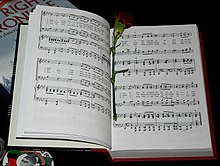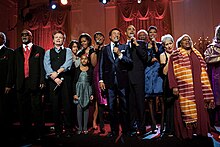Lift Every Voice and Sing
 Sheet music of "Lift Every Voice and Sing" | |
| Lyrics | James Weldon Johnson, 1900 |
|---|---|
| Music | J. Rosamond Johnson, 1905 |
"Lift Every Voice and Sing" – often referred to as the Black national anthem – is a song written as a poem by James Weldon Johnson (1871–1938) in 1900 and set to music by his brother J. Rosamond Johnson (1873–1954) in 1905.[1]
History
"Lift Every Voice and Sing" was publicly performed first as a poem as part of a celebration of Abraham Lincoln's birthday by Johnson's brother John. In 1919, the National Association for the Advancement of Colored People (NAACP) dubbed it "the Negro national hymn"[2] for its power in voicing a cry for liberation and affirmation for African-American people.[1]
The song is a prayer of thanksgiving for faithfulness and freedom, with imagery evoking the biblical Exodus from slavery to the freedom of the "promised land". "Lift Every Voice and Sing" is featured in 39 different Christian hymnals, and is sung in churches across North America.[3]
In 1939, Augusta Savage received a commission from the New York World's Fair and created a 16-foot (5 m) plaster sculpture called Lift Every Voice and Sing. Savage did not have funds to have it cast in bronze or to move and store it. Like other Fair temporary installations, the sculpture was destroyed at the close of the fair.[4]
Notable references and performances
In Maya Angelou's 1969 autobiography, I Know Why the Caged Bird Sings, the song is sung by the audience and students at Maya's eighth grade graduation, after a white school official dashes the educational aspirations of her class.[5]
In 1972, Kim Weston sang the song as the opening number for the Wattstax Festival at the Coliseum in Los Angeles. This performance was included in the film Wattstax made by Wolper Films. The music direction and recording was overseen by Stax Records engineer Terry Manning.
The 1989 film, Do the Right Thing, features a 30 second cover of the song, played on a solo saxophone by Branford Marsalis, during the opening logos.
In 1990, singer Melba Moore released a modern rendition of the song, which she recorded along with others including R&B artists Stephanie Mills, Freddie Jackson, Anita Baker, Dionne Warwick, Bobby Brown, Stevie Wonder, Jeffrey Osborne, and Howard Hewett; and gospel artists BeBe & CeCe Winans, Take 6, and The Clark Sisters, after which, "Lift Every Voice and Sing" was entered into the Congressional Record by Del. Walter Fauntroy (D-DC).[6]
In 2008, jazz singer Rene Marie was asked to perform the national anthem at a civic event in Denver, Colorado, where she caused a controversy by substituting the words of "Lift Every Voice and Sing" into the song. This arrangement of the words of "Lift Every Voice and Sing" with the melody of "The Star Spangled Banner" became part of the titular suite on her 2011 CD release, The Voice of My Beautiful Country.[7]
On January 20, 2009, the Rev. Joseph Lowery, a civil rights movement leader who co-founded and is a former president of the Southern Christian Leadership Conference, used a near-verbatim recitation of the song's third stanza to begin his benediction at the inauguration ceremony for President Barack Obama.

On September 24, 2016, this song was sung by mezzo-soprano Denyce Graves and chorus at the conclusion of the opening ceremonies of the National Museum of African American History and Culture, at which Obama delivered the keynote address.
On October 19, 2017, when white supremacist leader Richard Spencer spoke at the University of Florida, the university's carillon played "Lift Ev'ry Voice and Sing" to convey a message of unity.[8]
On April 14, 2018, Beyoncé included the song in the set list of her concert at the Coachella Valley Music and Arts Festival.
In 2020, Google played a spoken word version of the song in a Google Doodle celebrating the Juneteenth holiday, performed by LeVar Burton.
Lyrics
Lift ev’ry voice and sing,
‘Til earth and heaven ring,
Ring with the harmonies of Liberty;
Let our rejoicing rise
High as the list’ning skies,
Let it resound loud as the rolling sea.
Sing a song full of the faith that the dark past has taught us,
Sing a song full of the hope that the present has brought us;
Facing the rising sun of our new day begun,
Let us march on ’til victory is won.
Stony the road we t trod,
Bitter the chastening rod,
Felt in the days when hope unborn had died;
Yet with a steady beat,
Have not our weary feet
Come to the place for which our fathers sighed?
We have come over a way that with tears has been watered,
We have come, treading our path through the blood of the slaughtered,
Out from the gloomy past,
‘Til now we stand at last
Where the white gleam of our bright star is cast.
God of our weary years,
God of our silent tears,
Thou who has brought us thus far on the way;
Thou who has by Thy might
Led us into the light,
Keep us forever in the path, we pray.
Lest our feet stray from the places, our God, where we met Thee,
Lest, our hearts drunk with the wine of the world, we forget Thee;
Shadowed beneath Thy hand,
May we forever stand,
True to our God,
True to our native land.[9]
References
- ^ a b James, Timothy (Winter 2013). "The Story of the Black National Anthem, "Lift Ev'ry Voice and Sing", Written by James Weldon Johnson" (PDF). Selah. Vol. 1, no. 1. Archived from the original (PDF) on 16 February 2015. Retrieved 16 February 2015.
- ^ Touré (November 17, 2011). "Society It's Time for a New Black National Anthem". Time Magazine. Retrieved February 16, 2015.
- ^ "Lift Every Voice and Sing". Hymnary.org.
- ^ Bearden, Romare and Henderson, Harry. A History of African-American Artists (From 1792 to the Present), pp. 168–180, Pantheon Books (Random House), 1993, ISBN 0-394-57016-2
- ^ Angelou, Maya (1969). I Know Why the Caged Bird Sings. New York: Random House. pp. 169–184. ISBN 0-375-50789-2.
- ^ Anderson, Susan Heller. "Chronicle", The New York Times, April 18, 1990. Retrieved January 20, 2009.
- ^ Pellegrinelli, Lara (July 3, 2009). "Poetic License Raises a Star-Spangled Debate". All Things Considered. NPR. Retrieved January 15, 2012.
- ^ Diaz, Andrea; Chavez, Nicole (October 20, 2017), College's bell tower trolled white supremacist with black national anthem, CNN, retrieved 2017-10-20
- ^ "NAACP History: Lift Every Voice and Sing". NAACP. Retrieved 7 June 2020.
External links
- Free scores by J. Rosamond Johnson at the International Music Score Library Project (IMSLP)—including "Lift Every Voice and Sing"
- Lift Every Voice and Sing: A Celebration of the Negro National Anthem at the Wayback Machine (archived March 1, 2009), edited by Julian Bond and Sondra Kathryn Wilson
- NPR's Performance Today page on Black History Month 2003—includes a link to a RealPlayer version of the song
- ''Chicago Sun-Times columnist Lynn Sweet, transcript of Rev. Lowery's Inauguration Benediction
- Video of singing "Lift Every Voice and Sing" on YouTube led by Alice Walker and Dr. Rudolph Byrd at Emory University
